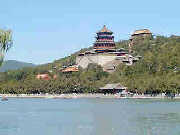 There are over 20 thousand design drafts of Yangshi Lei in existence, most of which are collected in National Library of China, the Palace Museum, the First Historical Archives of China and the Graduate School of Chinese Culture Relics. With various contents, such as the details of how sites were chosen, as well as programming, design and construction of Qing Dynasty imperial buildings including cities, palaces, gardens,altars, temples, mausoleums, mansions and others. The records are the most elaborate historical materials which also correspond with the remaining architecture.
There are over 20 thousand design drafts of Yangshi Lei in existence, most of which are collected in National Library of China, the Palace Museum, the First Historical Archives of China and the Graduate School of Chinese Culture Relics. With various contents, such as the details of how sites were chosen, as well as programming, design and construction of Qing Dynasty imperial buildings including cities, palaces, gardens,altars, temples, mausoleums, mansions and others. The records are the most elaborate historical materials which also correspond with the remaining architecture.
According to Wang Qiheng, an expert on Yangshi Lei, the design dradts adopted principles of projection and layering, which not only overthrows the old theory that the ancient Chinese structures has not undergone necessarily design, but also proves that the design of Chinese architecture employed advanced drawing technology as early as at least 200 years ago.
In 2003, the design drafts of the Yangshi Lei were listed as a Chinese literature heritage. Now they are being prepared to apply for the world remembrance heritage in 2005, which is set up by the United Nations Educational, Scientific, and Cultural Organization for precious literatures records, and selects new artifacts through public appraisal every two years.
 Yangshi Lei and the Summer Palace"
Yangshi Lei and the Summer Palace"
The Summer Palace, originally named "Qingyiyuan Garden", and situated by the Wanshou Mountain andKunmingLake, is the representative work of Yangshi Lei. In A.D.1750, emperor Qianlong built the Qinyiyuan Garden in honor of his mother and later constructed the Wisdom Sea long corridor and the Huishanyuan Garden, imitating the Jichangyuan Garden in Wuxi in Jiangsu Province. In addition, three mountains were built by the Kunming Lake according to the legends of Fangzhang,Penglaiand Yingzhou. In A.D.1775 the stone boat was constructed. During the construction process, the Yangshi Lei worked out lots of designs and purchased the architectural materials themselves.
In the process of constructing the Qingyiyuan Garden, the emperor ordered an 8-storied tower pulled down because a geomancer said that it was not fit to build a tower in the northwest of Beijing. Then the emperor ordered Yangshi Lei to rebuild a different structure, posing a challenge for the family. At last, they designedpavilionpointing in all directions copying the Huanghelou design (one of the three famous tower in the south of the Yangtze River), now named the Fuxiang Pavilion now. The design of the Fuxiang Pavilion has been well preserved in the National Library of China.
